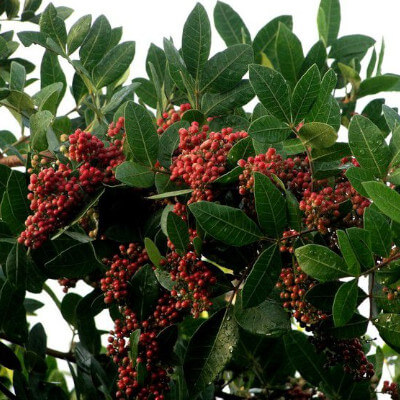
The Schinus terebinthifolia, commonly known as the Pink Peppercorn or False Pepper Tree, is a shrub native to South America, particularly Brazil and tropical regions. This ornamental and useful plant is widely cultivated in botanical gardens for its unique characteristics and aesthetic appeal. It typically grows to a height of 6 to 10 metres and produces vibrant green, evergreen foliage. Its compound leaves are slightly aromatic when crushed.
The characteristic clusters of red berries that appear after flowering make the Pink Peppercorn a true visual attraction. These fruits, often mistaken for pepper, add a touch of colour to the surrounding vegetation. In the Au Bois Vert botanical garden, located in Ivato near Antananarivo, Schinus terebinthifolia or Pink Peppercorn finds its place among many tropical species. It contributes to the ecosystem by attracting various pollinators, such as bees and butterflies, thanks to its small, discreet yet fragrant white flowers.
This plant adapts well to poor soils and arid conditions, making it a hardy and low-maintenance species. It also plays an important role in enhancing green spaces, particularly in hotels, restaurants, and lodges that seek to create a tropical atmosphere. At Au Bois Vert, visitors can admire this species while learning about its contribution to local biodiversity. Thanks to its resilience and visual appeal, the Pink Peppercorn remains a staple of tropical gardens.
Plant use
The Schinus terebinthifolia is not merely decorative; it has multiple uses that make it valuable in various contexts. Its red berries, often called pink peppercorns, are used as a spice. Their mild, slightly peppery flavour adds a subtle touch to many dishes, particularly in the refined cuisines of restaurants and lodges. These berries are commonly blended with black pepper to create well-balanced and aromatic seasonings. In traditional medicine, this plant also holds significant importance. Its leaves, bark, and berries are used for their antiseptic, anti-inflammatory, and antifungal properties. In Brazil, local populations utilise its extracts to treat skin conditions and minor infections. However, excessive consumption of pink peppercorns should be avoided due to their potential allergenic effects in some individuals. The usefulness of this shrub does not end there. Its wood is used to craft lightweight artisanal objects, while its leaves are sometimes employed to add fragrance to indoor spaces. In the Au Bois Vert botanical garden, this plant is showcased not only for its culinary and medicinal uses but also for its ecological role. It helps prevent soil erosion thanks to its strong root system, making it an essential element in sustainable landscaping. Visitors to the Ivato botanical garden can thus discover the many facets of Schinus terebinthifolia. Its ability to combine beauty, utility, and sustainability makes it a highly valued plant in tropical environments such as those of Antananarivo.
Key information
| Common name | Pink Peppercorn |
| Scientific name | Schinus terebinthifolia |
| Origin | South America (Brazil) |
| Natural habitat | Tropical and subtropical regions |
| Life cycle | Perennial |
| Flowering period | Spring and early summer |


